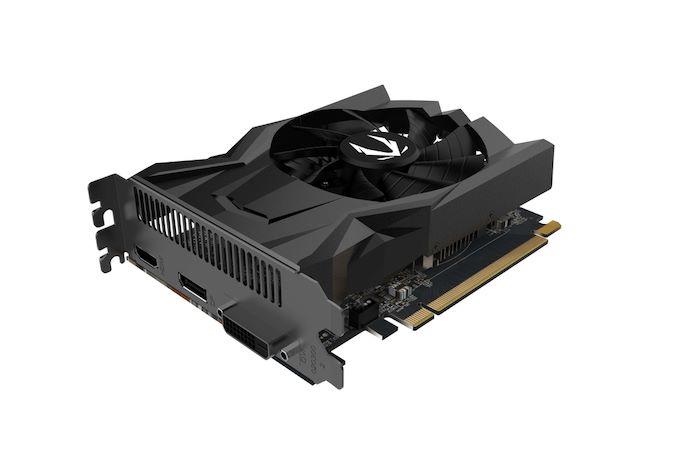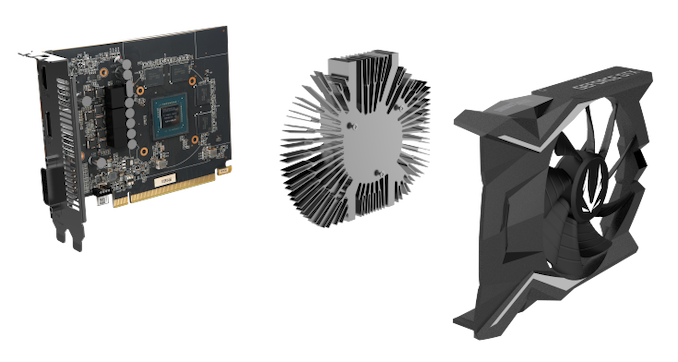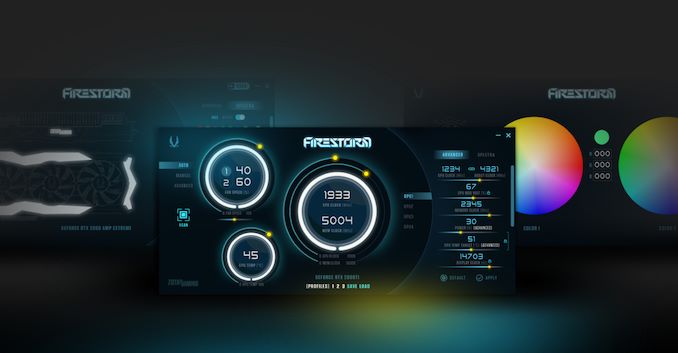The NVIDIA GeForce GTX 1650 Review, Feat. Zotac: Fighting Brute Force With Power Efficiency
by Ryan Smith & Nate Oh on May 3, 2019 10:15 AM ESTMeet The ZOTAC GAMING GeForce GTX 1650 OC
In what's becoming a theme of the GTX 16-series, the GeForce GTX 1650 is once again a pure virtual launch, where NVIDIA is not going for any Founders Edition models and all cards are up to their add-in board partners. For today's review, we take a look at ZOTAC's GeForce GTX 1650 OC, a diminutive 2-slot single-fan card with reference base clockspeed and mildly overclocked boost clock. With a TDP of 75W, the card pulls all its power from the slot, with is typical for most GeForce GTX xx50 parts.
| GeForce GTX 1650 Card Comparison | ||||
| GTX 1650 (Reference Specification) |
ZOTAC GTX 1650 GAMING OC | |||
| Base Clock | 1485MHz | 1485MHz | ||
| Boost Clock | 1665MHz | 1695MHz | ||
| Memory Clock | 8Gbps GDDR5 | 8Gbps GDDR5 | ||
| VRAM | 4GB | 4GB | ||
| TDP | 75W | 75W | ||
| Length | N/A | 5.94" | ||
| Width | N/A | 2-Slot | ||
| Cooler Type | N/A | Open Air | ||
| Price | $149 | $149 | ||
At just under 6", the Zotac GTX 1650 OC is compact enough most builds. As the card pulls power only from the PCIe slot, it's a conventional fit for mITX and other SFF builds, or simply as a no-fuss drop-in replacement. In turn, the Zotac GTX 1650 OC's cooling solution is one they've used before with their other mini ITX cards, combining a 90mm fan and 'sunflower' heatsink. This also provides headroom for ZOTAC to put a modest boost increase of 30MHz.
The design/shroud and output situation is likewise similar. One DVI port, one HDMI 2.0b port, and one DisplayPort covers all bases, including potential HTPC use. Of course, partners can always decide on different configurations but the power/cost-sensitive entry-level range is essentially standardized. VirtualLink is naturally not included here for several reasons, and in perspective the 30W USB-C controller power budget for VirtualLink would be 40% of the overall 75W TDP.
For overclocking and tweaking, ZOTAC has their in-house Firestorm utility updated for Turing, including support for auto-OC scanning as part of Turing's GPU Boost 4 technology.














126 Comments
View All Comments
Marlin1975 - Friday, May 3, 2019 - link
Not a bad card, but it is a bad price.drexnx - Friday, May 3, 2019 - link
yep, but if you look at the die size, you can see that they're kinda stuck - huge generational die size increase vs GP107, and even RX570/580 are only 232mm2 compared to 200mm2.I can see how AMD can happily sell 570s for the same price since that design has been long paid for vs. Turing and the MFG costs shouldn't be much higher
Karmena - Tuesday, May 7, 2019 - link
Check the prices of RX570, they cost 120$ on newegg. And you can get one under 150$tarqsharq - Tuesday, May 7, 2019 - link
And the RX570's come with The Division 2 and World War Z right now.You can get the ASrock version with 8GB VRAM for only $139!
0ldman79 - Sunday, May 19, 2019 - link
Problem is on an OEM box you'll have to upgrade the PSU as well.Dealing with normies for customers, the good ones will understand, but most of them wouldn't have bought a crappy OEM box in the first place. Most normies will buy the 1650 alone.
AMD needs 570ish performance without the need for auxiliary power.
Yojimbo - Friday, May 3, 2019 - link
Depending on the amount of gaming done, it probably saves over 50 dollars in electricity costs over a 2 year period compared to the RX 570. Of course the 570 is a bit faster on average.JoeyJoJo123 - Friday, May 3, 2019 - link
Nobody in their right mind that's specifically on the market for an aftermarket GPU (a buying decision that comes about BECAUSE they're dissatisfied with the current framerate or performance of their existing, or lack of, a GPU) is making their primary purchasing decision on power savings alone. In other words, people aren't saying "Man, my ForkNight performance is good, but my power bills are too high! In order to remedy the exorbitant cost of my power bill, I'm going to go out and purchase a $150 GPU (which is more than 1 month of my power bill alone), even if it offers the same performance of my current GPU, just to save money on my power bill!"Someone might make that their primary purchasing decision for a power supply, because outside of being able to supply a given wattage for the system, the only thing that matters is its efficiency, and yes, over the long term higher efficiency PSUs are better built, last longer, and provide a justifiable hidden cost savings.
Lower power for the same performance at a similar enough price can be a tie-breaker between two competing options, but that's not the case here for the 1650. It has essentially outpriced itself from competing viably in the lower budget GPU market.
Yojimbo - Friday, May 3, 2019 - link
I don't know what you consider being in a right mind is, but anyone making a cost sensitive buying decision that is not considering total cost of ownership is not making his decision correctly. The electricity is not free unless one has some special arrangement. It will be paid for and it will reduce one's wealth and ability to make other purchases.logamaniac - Friday, May 3, 2019 - link
So I assume you measure the efficiency of the AC unit in your car and how it relates to your gas mileage over duration of ownership as well? since you're so worried about every calculation in making that buying decision?serpretetsky - Friday, May 3, 2019 - link
It doesn't really change the argument if he does or does not take into account his AC unit in his car. Electricity is not free. You can ignore the price of electricity if you want, but your decision to ignore it or not does not change the total cost of ownership. (I'm not defending the electricity calculations above, I haven't verified them)